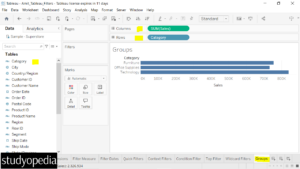05 Dec Tableau – Create a Group
In Tableau, groups are a way to categorize dimensions based on specific conditions or characteristics. Let us see how to create a group in Tableau, but first, let us understand the types of Tableau.
Types of Groups in Tableau
- Dimension Groups: Group dimensions based on specific attributes or conditions.
- Measure Groups: Group measures based on specific conditions or ranges.
Create groups in Tableau and group specific fields together. We will aggregate the values of the two categories together.
Before moving further, we’ve prepared a video tutorial on how to create a group in Tableau:
Create a group in Tableau
Let us create a new sheet and name it as Groups in the same Amit_Tableau_Filters.twb Tableau Workbook.
Drag the Dimension Category to the Rows shelf and Measure Sales to the Columns shelf. It will create a horizontal bar chart as shown below:

Now, right-click on the Category, and click Create, and then Group:

The Create Group window is now visible:

Add the name of the field, and then Group the categories. We will use the CTRL key on the keyboard and select any two categories. Let’s say, we will select the Furniture and Technology categories.
After that, click the Group button:

Now, the group of Furniture and Technology is visible. Click OK to create a group:

On the left, a new Dimension is now visible with the name Category (group):

Drag the new dimension Category (group) to the Rows shelf and now the sum of sales for the group is also visible:

If you liked the tutorial, spread the word and share the link and our website Studyopedia with others.
For Videos, Join Our YouTube Channel: Join Now
Read More:


No Comments